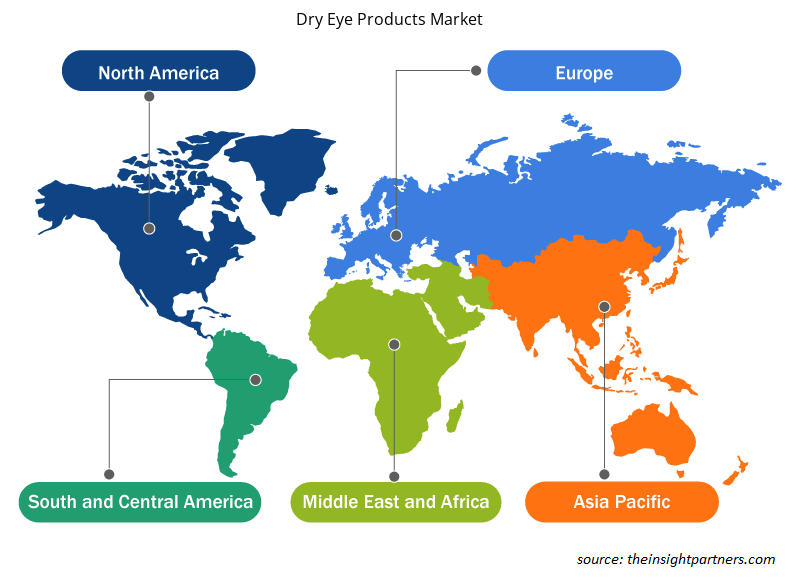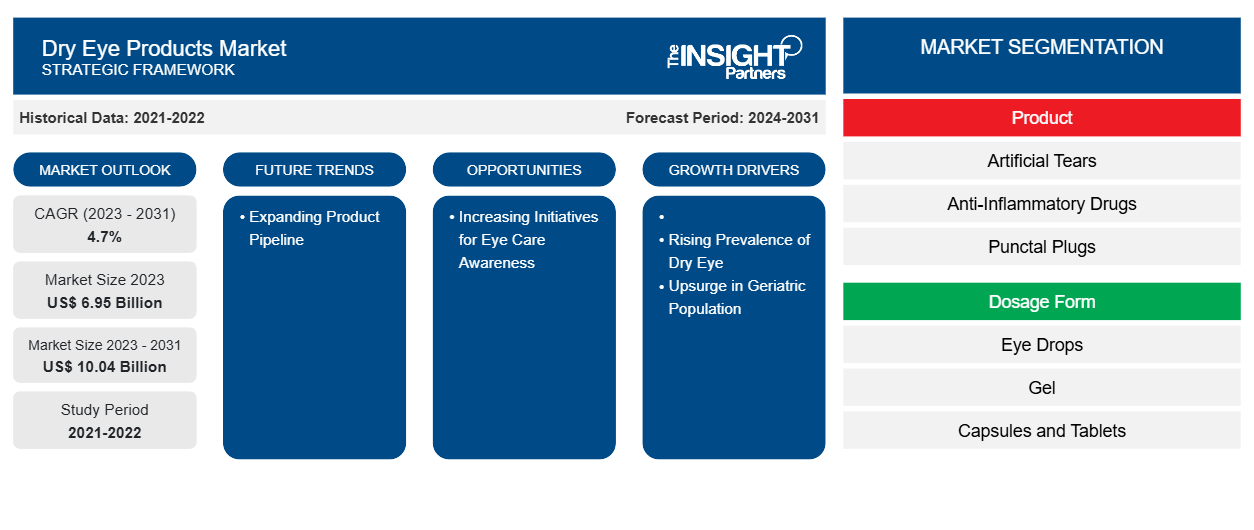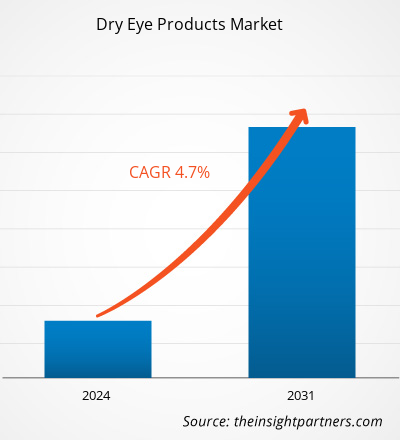干眼症产品市场规模预计将从 2023 年的 69.5 亿美元增长到 2031 年的 100.4 亿美元,2023-2031 年期间的复合年增长率为 4.7%。
报告包括当前 干眼产品市场趋势及其在预测期内可预见的影响所带来的增长前景。干眼症是一种以泪液质量不足来润滑和滋养眼睛或泪液蒸发过快为特征的疾病。随着荷尔蒙的变化,随着年龄的增长,人们产生泪液的倾向会降低。干眼症在男性和女性中都很常见。然而,女性中记录的病例更多,主要是那些经历过更年期的人。干眼症是一种慢性疾病,没有特定的治疗方法,但治疗可以帮助控制症状。预计发展中国家将在未来几年为干眼产品市场提供巨大的增长机会。
增长动力:
老年人口激增推动干眼产品市场增长
干眼症是一种常见的眼部疾病,影响着相当一部分人口,尤其是 50 岁以上的人群。中老年人是这种疾病的常见目标,其发病原因可能与佩戴隐形眼镜、自身免疫性疾病的流行、全身性药物影响以及屈光手术有关。随着预期寿命的延长以及老年人口病例的增加,干眼症的负担将继续增加。根据世界卫生组织 (WHO) 的数据,60 岁及以上人口将从 2020 年的 10 亿增加到 2030 年的 14 亿;到 2050 年,这一数字可能会进一步翻一番,达到约 20 亿。预计 2020 年至 2050 年,80 岁及以上人口的数量将增加两倍,达到 4.26 亿。根据美国眼科学会发表的一篇文章,DED 的风险会随着年龄的增长而增加。 DED 的患病率在 18-34 岁人群中为 2.7%,在 75 岁及以上人群中为 18.6%。美国疾病控制与预防中心 (CDC) 指出,在美国,25 岁以下人群糖尿病视网膜病变的患病率最低 (13.0%),65-79 岁人群患病率最高 (28.4%)。因此,随着全球老年人口的增长,对人工泪液等干眼产品的需求也在增加。
定制此报告以满足您的需求
您可以免费定制任何报告,包括本报告的部分内容、国家级分析、Excel 数据包,以及为初创企业和大学提供优惠和折扣
- 获取此报告的关键市场趋势。这个免费样品将包括数据分析,从市场趋势到估计和预测。
报告细分和范围:
干眼产品市场分析通过考虑以下部分来进行:产品、剂型、类型和分销渠道。
节段分析:
按产品划分,干眼产品市场细分为人工泪液、抗炎药、泪点塞、促泌剂、口服欧米茄补充剂等。2023 年,人工泪液部分占据了干眼产品最大的市场份额。抗炎药部分预计在 2023-2031 年期间的复合年增长率最高,为 5.7%。抗炎药进一步分为环孢菌素、皮质类固醇等。眼睛干涩是由于泪液分泌量低或眼睛中缺乏合适质量的泪膜造成的。眼睛缺乏润滑,主要是由于泪液不足,导致眼睛干涩。人工泪液有助于保持眼睛外表面的良好水分含量,从而润滑眼睛。它们通常作为非处方产品提供。人工泪液或眼药水有两种形式:含防腐剂和不含防腐剂。根据使用频率推荐。人工泪液也有凝胶和凝胶插入物形式。这些产品可能有副作用,例如视力模糊。
根据剂型,干眼产品市场分为眼药水、凝胶、胶囊和片剂等。眼药水部分在 2023 年占据了最大的市场份额。预计凝胶部分在 2023-2031 年期间的复合年增长率最高,为 5.2%。
按类型划分,干眼产品市场分为非处方药和处方药。非处方药在 2023 年占据了较大的市场份额,预计在 2023-2031 年期间的复合年增长率将达到 5.1%。处方眼药水用于治疗干眼症等疾病以及降低青光眼患者的眼压 (IOP)。
按分销渠道划分,干眼产品市场分为零售药店、医院药店和在线药店。零售药店在 2023 年占据最大的市场份额。预计在线药店在预测期内的复合年增长率最高,为 5.7%。
区域分析:
干眼产品市场报告的范围包括北美、欧洲、亚太地区、中东和非洲以及南美和中美。2023 年,北美占据了干眼产品最大的市场份额。该地区市场的增长是由人们对干眼症的认识不断提高、人口老龄化加剧、技术进步以及眼病病例增加所推动的。此外,由于新药频繁推出,各种药物易于获得,这是推动该地区市场增长的关键因素之一。
欧洲在全球干眼产品市场中占有重要地位,预计在预测期内将录得强劲增长率。该地区干眼产品市场的增长主要归因于青光眼发病率的上升(导致干眼症病例的增加)、新产品的供应、老龄化人口的激增以及对 DED 的认识不断提高。德国是一个有大量眼疾患者的国家。由于青光眼、白内障和视网膜脱离等眼科疾病的广泛发生,眼药水在该国变得越来越重要。根据 2021 年 5 月在《眼科杂志》上发表的《德国视网膜脱离的发病率:古腾堡健康研究的结果》,德国 35-74 岁年龄段的视网膜脱离发病率为每年每 100,000 人 42 人。与其他欧洲国家的估计相比,德国这个年龄段人群的视网膜脱落发病率较高。因此,随着德国人口老龄化,眼药水的需求量也在增加。
干眼产品市场区域洞察
Insight Partners 的分析师已详尽解释了预测期内影响干眼产品市场的区域趋势和因素。本节还讨论了北美、欧洲、亚太地区、中东和非洲以及南美和中美洲的干眼产品市场细分和地理位置。

- 获取干眼产品市场的区域特定数据
干眼产品市场报告范围
| 报告属性 | 细节 |
|---|---|
| 2023 年的市场规模 | 69.5亿美元 |
| 2031 年市场规模 | 100.4亿美元 |
| 全球复合年增长率(2023 - 2031) | 4.7% |
| 史料 | 2021-2022 |
| 预测期 | 2024-2031 |
| 涵盖的领域 | 按产品
|
| 覆盖地区和国家 | 北美
|
| 市场领导者和主要公司简介 |
|
市场参与者密度:了解其对商业动态的影响
干眼产品市场正在快速增长,这得益于终端用户需求的不断增长,而这些需求又源于消费者偏好的不断变化、技术进步以及对产品优势的认识不断提高等因素。随着需求的增加,企业正在扩大其产品范围,进行创新以满足消费者的需求,并利用新兴趋势,从而进一步推动市场增长。
市场参与者密度是指在特定市场或行业内运营的企业或公司的分布情况。它表明在给定市场空间中,相对于其规模或总市场价值,有多少竞争对手(市场参与者)存在。
在干眼产品市场运营的主要公司有:
- 参天制药株式会社
- 强生公司,
- OASIS 医疗
- URSAPHARM 药品有限公司
- 乐敦制药有限公司
- OCuSOFT 公司,
免责声明:上面列出的公司没有按照任何特定顺序排列。

- 获取干眼产品市场顶级关键参与者概述
竞争格局和重点公司:
干眼产品市场预测可以帮助该市场的利益相关者制定增长战略。参天制药有限公司、强生公司、OASIS Medical、URSAPHARM Arzneimittel GmbH、乐敦制药有限公司、OCuSOFT Inc、博士伦医疗公司、艾伯维公司、Prestige Consumer Healthcare Inc、Farmigea SpA 和爱尔康公司是干眼产品市场报告中介绍的知名公司。这些公司专注于开发新技术、升级现有产品并扩大其地理覆盖范围,以满足全球日益增长的消费者需求。根据公司新闻稿,以下是市场上一些主要公司的最新发展:
- 2023 年 9 月,Bausch Health Companies Inc 的子公司 Bausch + Lomb Corporation(Bausch + Lomb)完成了对 XIIDRA(lifitegrast 眼科溶液)5% 的收购,这是一种非类固醇眼药水,专门用于治疗干眼症的体征和症状。该产品专门针对与干眼症相关的炎症和某些其他眼科资产。
- 2022 年 11 月,参天制药株式会社在日本推出了 DIQUAS LX 眼科溶液 3%(地夸磷索钠)。DIQUAS LX 溶液是一种需要每天三次滴入一滴以治疗干眼症的配方。
- 2022 年 8 月,爱尔康与 Aerie Pharmaceuticals Inc. 达成最终合并协议。作为该交易的一部分,爱尔康收购了 Aerie。此次交易有助于爱尔康凭借其不断增长的商业产品组合和开发渠道,增强其在眼科药物领域的地位。
- 2021 年 7 月,TheraTears 被 Prestige Consumer Healthcare Inc. 收购。收购 TheraTears 增强了 Prestige 领先的眼部护理产品组合,并为公司提供了新的长期增长前景。
- 2021 年 2 月,艾尔建推出了 Refresh Digital,这是一款新型润滑眼药水,专门用于缓解长时间看屏幕引起的干燥和刺激。
- 2020 年 6 月,OCuSOFT Inc. 与 EKKDA Research LLC 签订了销售分销协议。该合作关系有助于合作伙伴在眼科和验光相关业务中建立和发展。EKKDA Research LLC 的项目主要侧重于眼部护理。
- 2020 年 5 月,AbbVie Inc 收购了 Allergan plc,这是该公司无机业务战略的一部分。此次收购使该公司能够进入并扩大其在眼科护理相关市场的业务组合。
- 2020年1月,参天制药株式会社作为其在中国业务扩展的一部分,为其中国子公司“参天制药(中国)有限公司”建造了第二家工厂,以满足中国日益增长的产品需求。
- 历史分析(2 年)、基准年、预测(7 年)及复合年增长率
- PEST 和 SWOT 分析
- 市场规模价值/数量 - 全球、区域、国家
- 行业和竞争格局
- Excel 数据集



Report Coverage
Revenue forecast, Company Analysis, Industry landscape, Growth factors, and Trends

Segment Covered
This text is related
to segments covered.

Regional Scope
North America, Europe, Asia Pacific, Middle East & Africa, South & Central America

Country Scope
This text is related
to country scope.
常见问题
The dry eye products market majorly consists of the players such as Santen Pharmaceutical Co Ltd, Johnson & Johnson, OASIS Medical, URSAPHARM Arzneimittel GmbH, Rohto Pharmaceutical Co Ltd, OCuSOFT Inc, Bausch Health Companies Inc, AbbVie Inc, Prestige Consumer Healthcare Inc, Farmigea SpA and Alcon AG.
US holds the largest market share in dry eye products market. DED is a common but underdiagnosed condition in the US, and an increase in the population age can be associated with the surging prevalence of this disease. According to the Centers for Disease Control and Prevention (CDC), age-related eye diseases such as cataract, macular degeneration, diabetic retinopathy, and glaucoma are the primary causes of blindness and impaired vision in the US. Other common eye disorders include amblyopia and strabismus. Dry eye disease is expected to affect as many as 2.79 million US men by 2030.
The dry eye products market, based on product, is segmented into artificial tears, anti-inflammatory drugs, punctal plugs, secretagogues, oral omega supplements, and others. The artificial tears segment held the largest dry eye products market share in 2023. The anti-inflammatory drugs segment is anticipated to register the highest CAGR during 2023–2031.
The dry eye products market by dosage form is bifurcated into OTC and prescription. The OTC segment held a larger share of the market in 2023, and it is anticipated to register a higher CAGR of 5.1% during 2023–2031.
The factors that are driving growth of the market are the rising prevalence of dry eye and upsurge in geriatric population.
Dry eye is a condition characterized by the lack of adequate quality of tears to lubricate and nourish the eye or by a quick evaporation of tears. With hormonal changes, as people get older, the tendency to produce tears decreases. Dry eye is common in both males and females. However, more cases are recorded in women, mainly those who have gone through menopause. Dry eye is a chronic condition that doesn’t have a specific cure, but treatments can help manage the symptoms.
The dry eye products market by distribution channel, is categorized into retail pharmacies, hospital pharmacies, and online pharmacies. The retail pharmacies segment held the largest dry eye products market share in 2023. The online pharmacies segment is anticipated to register the highest CAGR of 5.7%.
Asia Pacific is expected to be the fastest growing region in the dry eye products market. The dry eye products market in Asia Pacific is expected to register the highest CAGR during the forecast period. According to NIH, in China, ~20–30% of people are diagnosed with dry eye conditions every year. The dry eye products market in China is quite competitive, with the presence of both domestic and international pharmaceutical companies. Novaliq has established a strategic cooperation with Jiangsu Hengrui Pharmaceuticals to manufacture, develop, and commercialize NOV03 for the treatment of dry eye disease.
Trends and growth analysis reports related to Life Sciences : READ MORE..
The List of Companies - Dry Eye Products Market
- Santen Pharmaceutical Co., Ltd.
- Johnson & Johnson
- OASIS Medical
- URSAPHARM Arzneimittel GmbH
- Rohto Pharmaceutical Co Ltd
- OCuSOFT Inc.
- Bausch Health Companies Inc
- AbbVie Inc
- Prestige Consumer Healthcare Inc.
- Farmigea SpA
- Alcon AG
The Insight Partners performs research in 4 major stages: Data Collection & Secondary Research, Primary Research, Data Analysis and Data Triangulation & Final Review.
- Data Collection and Secondary Research:
As a market research and consulting firm operating from a decade, we have published and advised several client across the globe. First step for any study will start with an assessment of currently available data and insights from existing reports. Further, historical and current market information is collected from Investor Presentations, Annual Reports, SEC Filings, etc., and other information related to company’s performance and market positioning are gathered from Paid Databases (Factiva, Hoovers, and Reuters) and various other publications available in public domain.
Several associations trade associates, technical forums, institutes, societies and organization are accessed to gain technical as well as market related insights through their publications such as research papers, blogs and press releases related to the studies are referred to get cues about the market. Further, white papers, journals, magazines, and other news articles published in last 3 years are scrutinized and analyzed to understand the current market trends.
- Primary Research:
The primarily interview analysis comprise of data obtained from industry participants interview and answers to survey questions gathered by in-house primary team.
For primary research, interviews are conducted with industry experts/CEOs/Marketing Managers/VPs/Subject Matter Experts from both demand and supply side to get a 360-degree view of the market. The primary team conducts several interviews based on the complexity of the markets to understand the various market trends and dynamics which makes research more credible and precise.
A typical research interview fulfils the following functions:
- Provides first-hand information on the market size, market trends, growth trends, competitive landscape, and outlook
- Validates and strengthens in-house secondary research findings
- Develops the analysis team’s expertise and market understanding
Primary research involves email interactions and telephone interviews for each market, category, segment, and sub-segment across geographies. The participants who typically take part in such a process include, but are not limited to:
- Industry participants: VPs, business development managers, market intelligence managers and national sales managers
- Outside experts: Valuation experts, research analysts and key opinion leaders specializing in the electronics and semiconductor industry.
Below is the breakup of our primary respondents by company, designation, and region:

Once we receive the confirmation from primary research sources or primary respondents, we finalize the base year market estimation and forecast the data as per the macroeconomic and microeconomic factors assessed during data collection.
- Data Analysis:
Once data is validated through both secondary as well as primary respondents, we finalize the market estimations by hypothesis formulation and factor analysis at regional and country level.
- Macro-Economic Factor Analysis:
We analyse macroeconomic indicators such the gross domestic product (GDP), increase in the demand for goods and services across industries, technological advancement, regional economic growth, governmental policies, the influence of COVID-19, PEST analysis, and other aspects. This analysis aids in setting benchmarks for various nations/regions and approximating market splits. Additionally, the general trend of the aforementioned components aid in determining the market's development possibilities.
- Country Level Data:
Various factors that are especially aligned to the country are taken into account to determine the market size for a certain area and country, including the presence of vendors, such as headquarters and offices, the country's GDP, demand patterns, and industry growth. To comprehend the market dynamics for the nation, a number of growth variables, inhibitors, application areas, and current market trends are researched. The aforementioned elements aid in determining the country's overall market's growth potential.
- Company Profile:
The “Table of Contents” is formulated by listing and analyzing more than 25 - 30 companies operating in the market ecosystem across geographies. However, we profile only 10 companies as a standard practice in our syndicate reports. These 10 companies comprise leading, emerging, and regional players. Nonetheless, our analysis is not restricted to the 10 listed companies, we also analyze other companies present in the market to develop a holistic view and understand the prevailing trends. The “Company Profiles” section in the report covers key facts, business description, products & services, financial information, SWOT analysis, and key developments. The financial information presented is extracted from the annual reports and official documents of the publicly listed companies. Upon collecting the information for the sections of respective companies, we verify them via various primary sources and then compile the data in respective company profiles. The company level information helps us in deriving the base number as well as in forecasting the market size.
- Developing Base Number:
Aggregation of sales statistics (2020-2022) and macro-economic factor, and other secondary and primary research insights are utilized to arrive at base number and related market shares for 2022. The data gaps are identified in this step and relevant market data is analyzed, collected from paid primary interviews or databases. On finalizing the base year market size, forecasts are developed on the basis of macro-economic, industry and market growth factors and company level analysis.
- Data Triangulation and Final Review:
The market findings and base year market size calculations are validated from supply as well as demand side. Demand side validations are based on macro-economic factor analysis and benchmarks for respective regions and countries. In case of supply side validations, revenues of major companies are estimated (in case not available) based on industry benchmark, approximate number of employees, product portfolio, and primary interviews revenues are gathered. Further revenue from target product/service segment is assessed to avoid overshooting of market statistics. In case of heavy deviations between supply and demand side values, all thes steps are repeated to achieve synchronization.
We follow an iterative model, wherein we share our research findings with Subject Matter Experts (SME’s) and Key Opinion Leaders (KOLs) until consensus view of the market is not formulated – this model negates any drastic deviation in the opinions of experts. Only validated and universally acceptable research findings are quoted in our reports.
We have important check points that we use to validate our research findings – which we call – data triangulation, where we validate the information, we generate from secondary sources with primary interviews and then we re-validate with our internal data bases and Subject matter experts. This comprehensive model enables us to deliver high quality, reliable data in shortest possible time.


 获取此报告的免费样本
获取此报告的免费样本